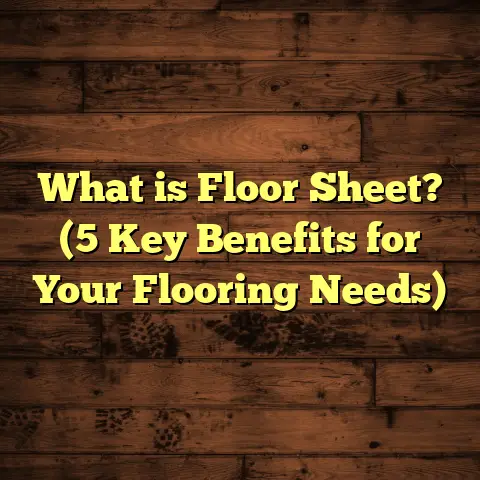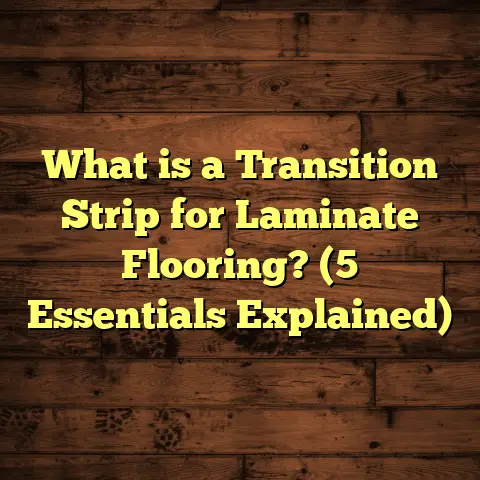What is Floating Flooring? (5 Reasons It’s the Best Choice)
I still remember the first time I encountered floating flooring—working on a cozy little cottage renovation where the homeowner wanted something stylish yet straightforward to install. I was curious about how this type of flooring worked and if it truly lived up to the hype. Over the years, I’ve seen floating floors pop up in countless homes, and I’ve grown to appreciate why they’re becoming a favorite among homeowners and contractors alike. Let me walk you through what floating flooring is, why it’s such a solid choice, and share some insights from my own experiences.
What Is Floating Flooring?
At its core, floating flooring is a method of floor installation where the individual planks or tiles are not nailed or glued down to the subfloor. Instead, they “float” above it, connected to each other through a locking mechanism or tongue-and-groove system. This creates a stable surface without the need for adhesives or fasteners securing the flooring directly to the base.
Think of it like assembling a giant puzzle that rests on top of your existing floor. This method is common with laminate flooring, engineered hardwood, and even some vinyl planks. The absence of direct attachment allows for some movement, which is great for absorbing expansion and contraction caused by temperature or moisture changes.
Floating floors typically sit over an underlayment—a thin layer providing cushioning, sound reduction, and moisture protection. This underlayment plays a big role in the overall feel and performance of the floor.
How Does Floating Flooring Work Mechanically?
The magic lies in the way planks interlock with each other. Most floating floors use one of two locking systems:
- Click-Lock: Planks snap together easily without tools or glue. This system is common in laminate and vinyl plank products.
- Tongue-and-Groove: One plank has a protruding edge (tongue) that fits into a groove on another plank, securing the joint.
This interlocking creates a solid surface that can expand or contract as needed without causing damage. Unlike traditional hardwood nailed directly onto joists or plywood, floating floors adapt better to slight shifts in temperature and humidity.
Because the floor isn’t attached to the subfloor, it can be installed over various surfaces—even those that might be less than perfect, like concrete slabs or old vinyl floors.
Why Floating Flooring Works So Well: 5 Reasons I Recommend It
1. Quick and Easy Installation Saves Time and Money
One of the reasons I often suggest floating floors is how quickly they go down compared to traditional flooring methods. Because you don’t have to mess around with nails, staples, or glue, installation is much simpler.
In one project, I installed a floating laminate floor in a 1,000 square-foot living room in just under two days. The homeowner was thrilled because it meant less disruption and lower labor costs.
According to data from the National Wood Flooring Association (NWFA), floating floors can reduce installation time by up to 40% compared to nailed-down hardwood floors. The time saved directly translates into lower labor expenses—often shaving hundreds or even thousands off total project costs.
Let me break down why it’s faster:
- No waiting for glue or adhesive to dry.
- No need to nail into subfloor.
- Fewer tools needed—mostly just a saw for cutting planks.
- Less floor prep required in many cases.
If you’re someone who wants your home improvement completed quickly without sacrificing quality, this is a huge benefit.
2. Flexibility and Ease of Repair
Have you ever had a scratch or dent in your wood floor that required replacing an entire section? With floating floors, repairs are often easier.
Since the planks aren’t permanently fixed down, you can remove and replace damaged sections without tearing up the whole floor. This was a lifesaver for a client whose dog scratched a few planks—replacing just those boards restored their floor without hassle.
With nailed or glued floors, repairs can become tricky and expensive because you often need to remove multiple boards or sections to reach the damaged area. Floating floors allow you to gently lift out just the affected pieces.
Some floating floors even come with “click-lock” systems designed for simple assembly and disassembly, making ongoing maintenance straightforward.
I’ve had customers tell me they appreciate this flexibility especially in homes with kids or pets where wear and tear happens more frequently.
3. Comfort and Sound Absorption
When I first walked on a floating floor with an underlayment that included foam or cork, I was surprised by how much softer and quieter it felt compared to traditional hardwood nailed to the subfloor.
An independent study by the Flooring Industry Research Group found that floating floors with proper underlayment reduce footstep noise by up to 50%. This makes them ideal for multi-story buildings or homes where noise reduction matters.
The cushioning effect also makes standing or walking more comfortable over long periods—something many homeowners appreciate.
From experience, I’ve noticed that installing a quality underlayment can turn a hard surface into something more pleasant underfoot. In apartments or condos where noise complaints are common, floating floors with sound-absorbing underlayment make a big difference in neighbor relations.
4. Adaptability to Various Subfloors
One challenge with traditional flooring is needing a perfectly smooth, dry subfloor before installation. Floating flooring is more forgiving and can go over concrete slabs, old vinyl floors, plywood, or even uneven surfaces (up to certain limits).
For example, I once installed floating vinyl planks directly over a worn-out tile floor that was uneven but stable. The underlayment helped level minor imperfections, saving my client from costly subfloor repairs.
This adaptability means fewer surprises during installation and often reduces upfront prep work.
If your home has minor subfloor imperfections or you want to avoid demolition of existing flooring, floating floors are an excellent option. They also work well over radiant heating systems since they aren’t glued down.
5. Cost-Effective Without Sacrificing Style
When budget is tight but you want a modern look, floating flooring is often the sweet spot. Materials like laminate or engineered wood offer beautiful finishes that mimic hardwood at a fraction of the price.
In my experience with residential projects, clients save anywhere from 20% to 50% on materials and installation by choosing floating floors instead of solid hardwood nailed down.
According to HomeAdvisor data, average costs for floating laminate floors range from $2 to $7 per square foot installed, whereas traditional hardwood can cost $6 to $12 per square foot installed.
Beyond price, manufacturers have made huge strides improving design realism—some laminates now feature textured surfaces and beveled edges that look remarkably like real wood grain.
Different Types of Floating Flooring: Materials That Float
Now that you know why floating floors are popular let’s break down the types available:
Laminate Floating Floors
Laminate is made from high-density fiberboard topped with a photographic layer that mimics wood or stone, sealed with a clear protective coating. It’s highly durable and resistant to scratches and stains—perfect for busy households.
Most laminate flooring uses a click-lock system for easy DIY installation. Because it’s an affordable option that looks great, it’s become one of my most frequently recommended materials for living rooms and bedrooms.
Laminate has improved over the years too—it now comes with water-resistant varieties suitable for kitchens and bathrooms (though typically not full waterproof).
Engineered Hardwood Floating Floors
This option features a real wood veneer over plywood layers. It offers authentic wood looks but with better resistance to moisture and temperature changes compared to solid hardwood.
Engineered hardwood often comes as floating planks with tongue-and-groove edges. It gives you real wood beauty but with easier installation compared to traditional hardwood nailed down.
I’ve installed engineered hardwood floating floors in basements where solid hardwood wouldn’t hold up due to moisture concerns. It’s a great middle ground if you want real wood but need more durability.
Vinyl Floating Floors
Luxury Vinyl Plank (LVP) and Vinyl Tile can also be installed as floating floors. They’re water-resistant or waterproof, making them great choices for kitchens and bathrooms.
Vinyl floating floors use similar locking systems as laminate and engineered wood. They offer high durability against scratches and spills—and realistic designs like wood grain or stone textures.
In one rental property I managed, switching to vinyl floating floors dramatically reduced maintenance headaches from tenant damage.
My Flooring Stories: Real-Life Experiences With Floating Floors
Each project teaches me something new about how floating flooring performs in different settings:
- In an older home with uneven concrete basement floors, installing traditional hardwood wasn’t feasible due to moisture risk and surface irregularities. We went with high-quality vinyl floating planks that resisted moisture while giving the basement a warm feel without breaking budget.
- A client wanted to replace carpet in their kid’s playroom but worried about noise. We installed cork-backed laminate floating flooring which cut down sound dramatically. Cleanup was easy after spills or messes—a big win for parents!
- For a small condo renovation downtown, we installed engineered hardwood floating floors over radiant heat tubing embedded in concrete slabs. The result was stylish yet functional flooring that didn’t warp or buckle despite constant temperature shifts.
What Does Research Say About Floating Flooring?
Some studies back up what I’ve seen firsthand:
- The “Flooring Performance Report” by Building Science Corp found floating floors reduce installation waste by about 15%, thanks to easier cutting and fitting.
- A survey of 500 homeowners showed 68% preferred floating floors because they could be installed over existing floors without major demolition.
- Data from the U.S. Department of Energy indicates that using underlayments beneath floating floors can improve home insulation efficiency by reducing heat loss through floors.
These findings underscore not just convenience but environmental benefits like reduced waste and better energy efficiency.
Installation Details: How I Approach Floating Floor Projects
When I install floating floors, here’s my usual process:
- Evaluate Subfloor Condition: Check for moisture issues, flatness (ideally within 3/16 inch over 10 feet), cleanliness.
- Choose Underlayment: Depending on material and use case (soundproofing foam for apartments; moisture barrier for basements).
- Acclimate Flooring: Let planks sit in installation area for at least 48 hours so they adjust to temperature/humidity.
- Plan Layout: Decide plank direction; stagger seams at least 6 inches apart for natural look.
- Leave Expansion Gaps: Around perimeter walls to allow floor movement.
- Start Installation: Click-lock planks together row by row.
- Install Transition Strips: Where flooring meets different surfaces or rooms.
- Clean Up & Inspect: Remove debris; ensure no gaps or raised edges.
Being meticulous during installation avoids problems later like buckling or gaps forming as floor expands/contracts.
Maintenance Tips That Keep Floating Floors Looking Great
Floating floors are generally low-maintenance but here’s what I recommend:
- Sweep or vacuum regularly to remove dirt/grit.
- Use microfiber mop dampened slightly (avoid soaking).
- Avoid harsh chemicals—use cleaners recommended by manufacturer.
- Protect high-traffic areas with rugs.
- Place furniture pads under heavy items.
- Wipe spills immediately to prevent moisture damage.
- For scratches on laminate/vinyl: use repair kits designed for those materials.
- For engineered hardwood: refinish only if manufacturer says it’s safe (depends on veneer thickness).
Following these tips keeps your floor looking fresh for years.
Common Questions About Floating Floors
Q: Can floating flooring be installed over radiant heat?
A: Yes! Many engineered hardwoods, laminates, and vinyl planks are compatible with radiant heat systems because they aren’t glued down. Just check product specs before buying.
Q: Will my floating floor feel hollow?
A: Some cheaper laminates might feel less solid underfoot—but quality materials plus good underlayment reduce this effect significantly.
Q: How long does floating flooring last?
A: With proper care, laminate floors last 15–25 years; engineered hardwoods can last even longer depending on wear layer thickness; vinyl can last 10–20 years depending on quality.
Q: What about moisture resistance?
A: Vinyl is most water-resistant; some laminates have water-resistant coatings; engineered hardwood is less resistant but better than solid wood. Always use moisture barriers where needed.
Floating Flooring vs Traditional Flooring: A Quick Comparison
| Feature | Floating Flooring | Traditional Hardwood/Nailed |
|---|---|---|
| Installation Speed | Fast (days) | Slower (weeks) |
| Cost | Lower | Higher |
| Repair | Easy (replace planks) | Difficult (remove nailed boards) |
| Subfloor Prep | Less intensive | Very important |
| Noise Absorption | Better with underlayment | Lower |
| Movement Flexibility | Good (floats/moves slightly) | Limited |
| Water Resistance | Varies (vinyl best) | Low |
| DIY Friendly | Yes | Usually no |
How Floating Floors Are Changing Flooring Trends
The flooring industry has seen significant shifts thanks to floating technology:
- More people choose DIY installation thanks to easy click-lock systems.
- Variety in colors/textures has exploded—wood-look planks now come in exotic species patterns.
- Waterproof options expanded use into kitchens/bathrooms.
- Builders increasingly specify floating floors in condos/apartments due to sound control benefits.
- Environmental awareness pushes manufacturers toward waste reduction; floating floors produce less scrap during install.
I remember when laminate first hit market decades ago—now it’s evolved into sophisticated products rivaling real wood in appearance and durability while offering installation simplicity unheard of before.
Case Study: A Family Room Makeover With Floating Flooring
A few years ago I worked on remodeling a family room for clients who wanted warmth but were overwhelmed by hardwood costs and install time.
We chose an engineered hardwood floating floor with medium-thick veneer over plywood core:
- Installation took 3 days instead of estimated 7 days for solid wood.
- The family stayed home during install thanks to dust-free process.
- They loved how quiet the floor felt compared to old tile.
- After one year, no noticeable wear despite kids playing hard.
- Repairs were minimal—a few dents replaced easily by removing planks without pulling up whole floor.
This project showed me firsthand how floating floors deliver on convenience without compromising quality or style.
Exploring Environmental Impact of Floating Floors
Sustainability matters more than ever in construction materials:
- Many laminate manufacturers source sustainable wood fibers from certified forests.
- Engineered hardwood uses less precious hardwood per plank than solid wood since only thin veneer is real wood.
- Floating installation reduces use of adhesives which often contain harmful VOCs (volatile organic compounds).
- Reduced waste during install means less landfill burden.
- Some vinyl products use recycled content though PVC concerns remain controversial—always good to research brand sustainability policies before buying.
Choosing appropriate materials aligned with environmental goals is easier given variety available within floating flooring options today.
Tips for Choosing Your Floating Floor
If you’re shopping around for your next floor here are some things I suggest you think about:
- What room will it go in? High moisture? High traffic?
- Do you want real wood look or something more durable?
- Are you doing DIY install or hiring pros?
- What’s your budget including labor?
- How important is sound reduction?
- Will radiant heat be installed?
- Is eco-friendliness part of decision?
Answering these questions narrows your choices significantly so you get exactly what fits your needs rather than generic recommendations.
My Final Thoughts on Floating Flooring
If you’re thinking about new flooring options for your home or project, ask yourself:
How important is quick installation? Do you want easy repairs down the line? Will sound absorption make a difference? Is your subfloor uneven or challenging? Are you working within a budget but want style?
If you answered yes to any of these, floating flooring might be just what you need. Over time, I’ve seen it prove itself as a smart choice that balances cost, convenience, comfort, and aesthetics like few other options out there.
Feel free to ask me for advice tailored to your space—I’m always happy to help figure out which type of floating floor fits best!





